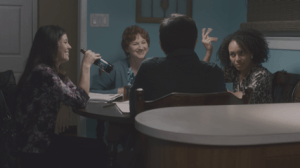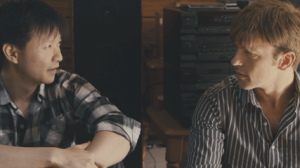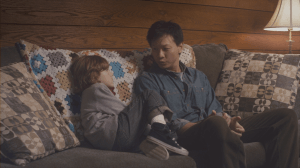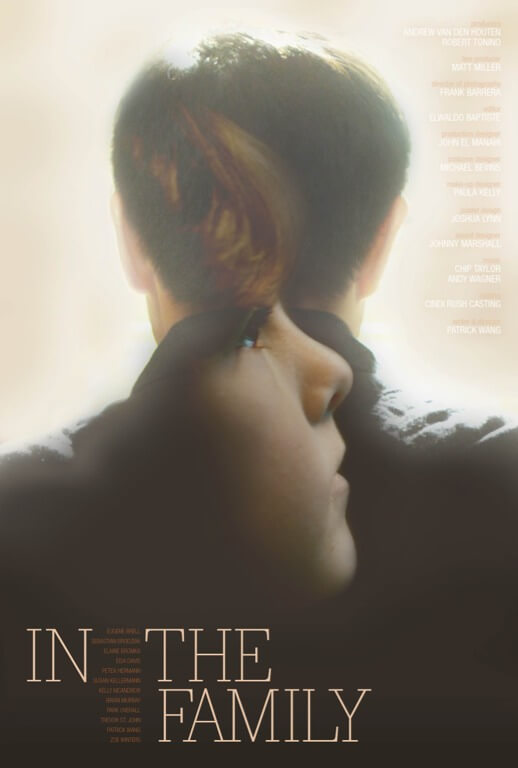“In the Family” (Dir. Patrick Wang; 2011) – I’d been eagerly awaiting to see this film for quite some time, a nearly 3-hour directorial debut by MIT alum Patrick Wang, shot over the course of 3 weeks in Yonkers, NY (near where I grew up).
In the town of Martin, Tennessee, Chip Hines, a precocious six year old, has only known life with his two dads, Cody and Joey – and a very good life it is. When Cody dies suddenly, Joey and Chip struggle to find their footing again. Just as they begin to, Cody’s will reveals he named his sister as Chip’s guardian. The years of Joey’s acceptance into the family unravel as Chip is taken away from him. In his now solitary home life, Joey searches for a solution. The law is not on his side, but friends are. Armed with their comfort and inspired by memories of Cody, Joey finds a path to peace with the family and closer to his son.
Based on the plot summary, and in the hands of a first-time director, the film could have easily ended up being a long, overdone, predictable melodrama. However, it is not. In fact, it is a brave and courageous feat of filmmaking. You are pulled so deep into the film, the 3 hours go by in an instant. The film is heartbreaking, honest, and powerful – I can’t recall the last film that made me as emotional as this one did. While it is a very different style of film than the “Kramer vs. Kramer”s of cinema history, it is a landmark film about family, what we define as family, and the role family plays in our lives. The fact that “In the Family” is able to convey this in the context of a non-traditional family, while circumventing every bit of stereotype, label, caricature, or scandalous depiction many films before it have typically relied on, makes it an even greater achievement.
[one_half content_align=”left”]
[/one_half][one_half_last content_align=”left”]
[/one_half_last]
The film is character driven with restrained performances all around. It is rich in behavioral nuances that could characterize any human being, while recognizing the little gestures we take for granted that our lives come to depend on. It invites you to see who this family is and experience what they go through, and it does so with a number of brave filmmaking choices. From the quiet and scoreless scenes, to the long observational takes, we are able to observe a serene family for what it is, as it’s torn apart by tragedy and society’s norms. From Joey’s denial, both visually and literally, in attempting to visit Cody at the hospital, to the slow angelic transition back to reality after the funeral, we witness a paternal bond between Joey and Chip that is genuine and real. The filmmaking techniques are risky, but they are right.
Processing it afterwards, it reminded me of an article I came across once dealing with diversity and tolerance. The article articulated my views on people, traditions, and society in a way I hadn’t been able to convey before. It discussed how every country has a majority culture, and in our country, the majority culture is defined as white, male, Christian, heterosexual, and free of disabilities. People who are not part of this majority culture are forced to deal with it while trying to develop and preserve their own identity. Those who are part of the majority culture though, never have to deal with anything but the majority culture. There isn’t any right or wrong in this – it’s simply reality.
Many of us often make the mistake that it is skin color, gender, or orientation that makes one good (the “expert”) at understanding or accepting a certain group, when in reality, it’s the ideas and attitudes with which we approach a situation, especially when the situation is seen as being different from what we’re familiar with. In other words, just because someone from the majority culture may start out with a larger “blind spot”, it doesn’t mean a straight white male can’t come to understand those outside of the majority culture. Similarly, just because you’re a gay black female, it doesn’t mean you’re an expert in tolerance and acceptance, it just means it’s easier for you to see a problem when there is one.
[one_half content_align=”center”]
[/one_half][one_half_last content_align=”center”]
[/one_half_last]
“In the Family” understands this, and in lieu of a climactic ending involving some big courtroom confrontation many films of this ilk would have resorted to, the film proposes a more inviting and gentler way of seeking acceptance and understanding. A constructive process for resolving our differences that appeals to our hearts and our ability to empathize – so long as we stop attacking and defending our views and morals, and just listen. It’s a powerful message, a plea for understanding, punctuated in the end by the film’s closing shot.
I’ve never written a movie review, but this is a film that relies on word of mouth, and requires effort on our part to seek out. It’s a 3-hour film involving a family with same-sex parents, so it’s unlikely to get picked up for mainstream distribution, which is probably why Patrick Wang is self-distributing it himself. The film only had 4 screenings in the Boston area this past weekend as part of the MIT Lecture Committee Series, but more screenings are lined up in a number of other cities. Over the last few weeks, the film has achieved some larger recognition and awareness as a result of a 4-star review by Roger Ebert, so hopefully more opportunities will come up for the Boston area again.
If you have a chance to see it, do so. Man or woman, straight or not, young or old, approach the film with an open mind, and you will walk out having experienced something magnificent. It is not a “gay” film, it is an important film – it’s a film that deserves to be seen.


